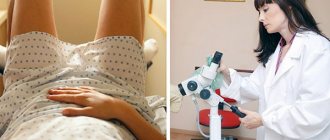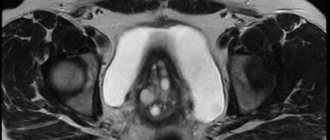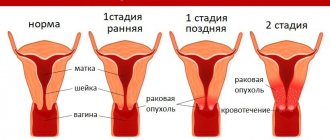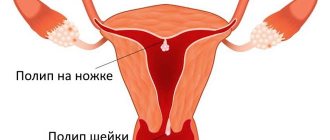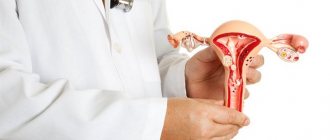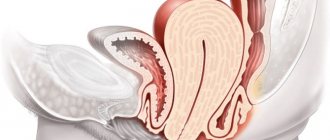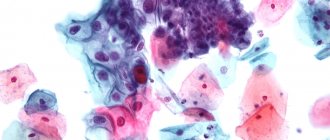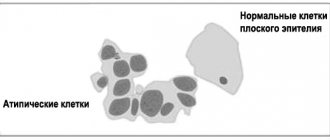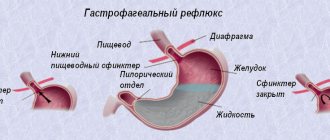experienced gynecologist, physiotherapist-resortologist E.K.
Ermolaeva Sign up for treatment
We are not treated anywhere: we are given a diagnosis and offered to try various ointments one after another!.. But here we receive intensive treatment for this particular area and feel a clear improvement!
From patient reviews
Leukoplakia of the cervix, leukoplakia of the vulva is ROUGHENING of the skin or mucous membrane.
Leukoplakia of the cervix and leukoplakia of the vulva are background diseases - diseases of the genital organs, against the background of which an oncological process can occur.
Leukoplakia of the cervix, leukoplakia of the vulva malignizes (“degenerates into cancer”), according to a number of authors, in 13-31% of cases.
| Photo of cervical leukoplakia. Leukoplakia presents as tender white patches on the cervix | |
| Photo of cervical leukoplakia. The same case. Treatment with Lugol's solution (Schiller test) allows you to more clearly determine the boundaries of leukoplakia |
| As you age, you stop enjoying many things: clothes, travel, restaurants, cosmetics, cars. Only health and vigor are always in demand. Leukoplakia of the cervix, leukoplakia of the vulva only gets worse if treatment is not effective. It is IMPORTANT to start moving in the RIGHT direction now! EVERYTHING you need to know about the right direction in the treatment of leukoplakia, see HERE: |
- Symptoms of leukoplakia of the cervix, vulva and vagina
- Causes of leukoplakia
- Leukoplakia and pregnancy
- Diagnosis of leukoplakia of the cervix and vulva
- Treatment of leukoplakia of the vulva, vagina and cervix
- Reasonable restrictions for leukoplakia
- Treatment of cervical leukoplakia WITHOUT PAIN
- Cost of non-contact treatment of leukoplakia
- Questions and answers about cervical leukoplakia
Diagnosis and treatment of leukoplakia by appointment by multi-line phone 8 (800) 500-52-74 (calls within Russia are free), or +7 (for international calls).
| ONLINE about cervical leukoplakia at [email protected] BOOK ONLINE for leukoplakia treatment here. BOOK online for leukoplakia treatment here. Buy coursework for treatment by phone or here. |
Buy coursework
Reviews about the treatment of leukoplakia
Kh.M., Nazran
I am so glad that I found you, you are such a kind, good, bright person. I tell everyone about you. And they also ask me what I found there in this Pyatigorsk. I answer, “I found myself a doctor.” Thank you very much for everything, happiness, health and all the best.
V.E., Kislovodsk
Thank you for the treatment you provided me. I wish you success and prosperity! It is very rare to find such professionalism. Your staff is very pleasant, the atmosphere fills with good emotions. Thank you for your health!!!
All reviews about the treatment of leukoplakia
Forms of vulvar leukoplakia
Considering the nature and severity of leukoplakia foci, lichen sclerosis has several forms:
- Simple (flat) leukoplakia of the vulva. It manifests itself in the formation of white plaques, which most often affect the vaginal walls and labia. The affected epithelial surface does not have concavities or convexities. It does not change its original shape and remains flat. In place of the removed plaques, skin with white patches remains. A simple form of lichen sclerosis can cover the entire vulvar area or occur in small areas.
- Hypertrophic (scaly) leukoplakia. This form of pathology is accompanied by the appearance of gray-white spots on the surface of the mucous membranes, rising above the surface of the epithelium. Foci of inflammation can connect to form a complete surface or a single chain. It is impossible to remove raised spots with a cotton swab in case of hypertrophic lichen.
- Erosive (warty) leukoplakia of the vulva. This stage of the disease is considered a precancerous condition. Inflammatory lesions look like white warts. Usually their surface is covered with cracks, abrasions or ulcers. Inflammation in plaques may develop.
Verrucous leukoplakia
Verrucous leukoplakia is considered the next stage in the development of simple leukoplakia. Local irritants contribute to its occurrence:
- Injury from sharp edges of a tooth or denture;
- Constant biting of areas of mucous membranes affected by simple leukoplakia;
- Frequent irritation of hyperkeratosis spots with spicy and hot foods;
- Smoking;
- Galvanic currents.
The main symptom of this form of the disease is pronounced keratinization, in which the upper layer of the oral mucosa noticeably thickens.
The area of verrucous leukoplakia rises above the level of nearby areas and stands out sharply by its color.
On palpation, a superficial compaction is felt.
Patients usually complain about a feeling of tightness and roughness at the site of formation of the pathological spot, pain and burning during eating.
Verrucous leukoplakia, in turn, is divided into:
- Plaque form, in which milky-white or straw-yellowish plaques with clear boundaries are formed, rising above the level of surrounding tissues.
- The warty form, characterized by warty or simply lumpy formations of dense consistency and grayish-white color. Warts grow up to 2-3 mm in height.
On palpation, warts and bumps are dense, mobile and painless.
This form of leukoplakia has a greater tendency to turn into a malignant tumor.
Causes of vulvar leukoplakia
The exact causes of lichen sclerosis have not been determined. Experts identify a number of factors that provoke changes in the cellular composition of the vulvar epithelium, which consequently leads to the development of leukoplakia. These include:
- chronic inflammatory pathologies of the reproductive system;
- genital herpes;
- dysplasia, erosion of the uterine cervix;
- hormone imbalance;
- obesity, diabetes mellitus;
- hypo-, vitamin deficiency;
- failure to comply with intimate hygiene rules;
- infection with human papillomavirus infection;
- genital injuries.
These factors become especially dangerous for menopausal patients and women over 40 years of age.
Some experts consider leukoplakia as a psychosomatic pathology that occurs against the background of a whole complex of psycho-emotional disorders (dissatisfaction with oneself and other people, distrust of relatives and friends, excessive demands on oneself, etc.).
Also, exposure to the above factors can cause the development of vulvar leukoplakia in a child. Therefore, regular preventive examinations in childhood play a special role.
Typical symptoms
Some women may not suspect the presence of the disease for a long time. Leukoplakia of the vulva is asymptomatic, but up to a certain point: one day, typical symptoms will force you to seek medical help. Typical symptoms of the disease include:
- Itching in the perineum (from occasional to painful and constant);
- Worsening of itching sensations at night, during physical work and at high temperatures;
- Psycho-emotional disorders such as depression and irritability, caused by constant itching;
- Inflammatory complications associated with infection of scratches.
Itching of the external genitalia can continue for years, especially if a woman ignores visits to the doctor and self-medicates (no folk remedies or unconventional methods can get rid of the problem).
Itching in the perineal area is a reason to be examined by a doctor
Symptoms of vulvar leukoplakia
At the initial stage, lichen sclerosus occurs without severe symptoms and you can learn about its development during routine or preventive examinations with a gynecologist. The disease can also be detected by examining the labia and clitoris, on which multiple, small white spots appear. Over time, they become keratinized, thicken and rise above the epithelial surface. At the same time, they become gray-white with a pearlescent tint. The area of changed epithelium may merge, enlarge, and spread to large areas of the vulva. In this case, a woman may experience a feeling of tingling or numbness in intimate places.
When the affected tissue becomes sclerotic or infected, swelling, dryness, tightness, and tension in the mucous membrane and skin of the genitals occur. Severe itching appears, which intensifies with urination, intimacy, movement and at night. Prolonged itching can cause psycho-emotional dysfunction (irritability, nervousness, etc.), loss of ability to work and exhaustion of the nervous system.
In areas of leukoplakia, the formation of multiple subepithelial hemorrhages is possible. Late stages of lichen are accompanied by pronounced manifestations. The skin and mucous membranes become folded and rigid. The labia minora are almost not defined; the labia majora become like thickened ridges. The vaginal opening sharply narrows, which makes sexual intercourse difficult.
What is oral leukoplakia
The term “leukoplakia” in medicine means keratinization (hyperkeratosis) of the upper layer of mucosal cells. In this case, the tissue in the affected area of the tongue, cheeks, gums, and palate becomes denser, and the person feels discomfort, a slight burning sensation and/or itching. Externally, such areas are identified by a characteristic grayish, whitish or yellowish tint. As a rule, the spots have irregular outlines, sharp or blurred edges.
This is what oral leukoplakia looks like
The disease develops slowly over several years; at the same time, it can both manifest itself with its characteristic signs and “hide” again. However, each time it gains strength and over time, the affected areas occupy an increasingly larger area, the color of the areas changes to brown, cracks, ulcers, and bleeding appear. This is regarded as the initial stage of malignant degeneration of the oral mucosa.
Diagnosis of lichen sclerosis
The diagnosis of vulvar leukoplakia is made by a doctor based on the existing symptoms, the patient’s complaints and the results of clinical studies. The following hardware and laboratory methods can be used to diagnose lichen sclerosis:
- Gynecological examination. During examination and palpation, the doctor discovers the presence of white keratinized spots on the mucous membranes and epithelium.
- Colposcopy (vulvoscopy). It is carried out to identify atypical cells indicating the transformation of affected tissues into a malignant formation.
- Vaginal smear analysis. Allows you to identify the state of the vaginal microflora and determine the presence of pathogenic microorganisms of the vulva.
- Schiller's test. It consists of staining inflamed skin spots, which allows for better visualization of foci of leukoplakia.
- Biopsy of vulvar tissue. The most effective diagnostic technique, which in 100% of cases allows you to make an accurate diagnosis.
Based on the information received, the doctor determines the form of lichen and, taking into account the patient’s health condition, develops an individual therapeutic program.
Diagnostics
A preliminary diagnosis is made based on anamnesis and examination of the patient in a gynecological chair. To clarify the condition, a woman is prescribed:
- cytology of urethral, vaginal and cervical smears - necessary to identify atypical cells indicating the onset of degeneration;
- PCR (polymerase chain reaction) - makes it possible to detect the presence of HPV (human papillomavirus) and determine its genotype;
- biopsy (sampling a piece of affected tissue for subsequent examination under an optical microscope) - allows you to evaluate the tumor and determine its characteristics;
- vulvoscopy (examination of vulvar tissue using a colposcope at high magnification) - helps to identify altered areas;
- sampling the contents of the uterine body and cervical canal for subsequent examination under a microscope;
- assessment of immune status is a specific blood test that helps a physician count the number of immune cells, the amount of antibodies and other substances that allow one to assess the current state of the body’s defense systems.
Differential diagnosis is mandatory, since at an early stage of formation, the symptoms of vulvar leukoplakia resemble other pathologies.
In the initial stage of development, vulvar leukoplakia may resemble symptoms of other diseases
They have similar features:
- Neurodermatitis. It is characterized by the development of itching in different parts of the body. The skin turns red, becomes dry and thickened, and becomes covered with pinkish-brown papular rashes.
- Vitiligo. The disease is manifested by a complete absence of pigmentation in some areas of the skin. The itching is minor. There are no atrophic changes.
- Uncompensated diabetes mellitus. Vulvar tissues are pasty and swollen. There is continuous itching. There are signs of inflammation.
- Lichen planus. The pathology is accompanied by papular rashes. After the integrity of the vesicles is damaged, atrophied or sclerotic areas form on the surface of the skin. The formation of keloid-like scars is possible.
If you suspect a skin pathology, a visit to a dermatologist is recommended.
How to treat vulvar leukoplakia
The tactics and treatment regimen for lichen sclerosis depends on the nature and degree of changes in the mucous membranes. Treatment of vulvar leukoplakia is aimed at preventing malignancy (malignization) of plaques and eliminating pathological symptoms. In the initial stages of the disease, complex conservative treatment is indicated, requiring constant monitoring by a specialist and monitoring its effectiveness through testing. If atypical cells are detected, surgical intervention is prescribed.
Questions and answers about the treatment of leukoplakia
Question: Is it possible to treat leukoplakia simultaneously using gynecological and therapeutic treatment programs? What will be the results and the planned cost of treatment? Answer: We consider a woman/girl as a whole and treat not the disease, but the sufferer (sick)! We provide a combination of gynecological and therapeutic spa treatment programs. And in fact, we always adjust the treatment program taking into account concomitant diseases of the gastrointestinal tract, cardiovascular, neuroendocrine and respiratory systems. The procedures are combined in such a way that each subsequent one potentiates (strengthens) the effect of the previous ones. The cost of a combined (combined) leukoplakia treatment program, as a rule, exceeds the cost of the main treatment program by no more than 15%. Sincerely, Chief Physician of the Resort Clinic for Women's Health, Ph.D. honey. Sciences O.Yu. Ermolaev.
Question: I have been suffering from LEUKOPLAKIA and CRAUROSIS for 5 years since my first visit to the doctor. I was not treated with anything other than ointments. How is it possible to BUY a COURSE for the treatment of kraurosis to you on a commercial basis? We really need your help in the treatment of leukoplakia and kraurosis! N.A., St. Petersburg. Answer: To buy a course for the treatment of kraurosis and leukoplakia, you need to call the Women's Health Resort Clinic in Pyatigorsk by phone 8 (800) 500-52-74 (toll-free within Russia) or +7 and agree on the start date of treatment.
| ONLINE about the treatment of leukoplakia at BOOK ONLINE for leukoplakia treatment here. BOOK online for leukoplakia treatment here. Buy a course for the treatment of leukoplakia by calling +7 or here. |
| Photo of cervical leukoplakia. A large white area with a clear outline is indicated by an arrow. |
Question: I was diagnosed with LEUKOPLAKIA of the cervix. How long can it go untreated? K.M., Karachaevsk. Answer: It is advisable not to delay treatment of leukoplakia.
Question: Can leukoplakia develop into cancer? Z.L., Nalchik. Answer: “DEGRIFICATION” of leukoplakia into CANCER (malignization) occurs in 13-15% of cases.
Question: During a medical examination, I was diagnosed with leukoplakia. How soon after radio wave treatment can I begin work involving ionizing radiation? V.O., Tyumen. Answer: This question should be asked to an occupational pathologist, because If you have leukoplakia, there are restrictions on your profession.
Question: White and pink blisters appeared on my TONGUE. I went to the dentist and they took swabs from me. The analysis showed that I have leukoplakia. I smoke, but I'm going to quit. Please tell me how to cure this? Zh.F., Moscow. Answer: There is currently no specific treatment for leukoplakia. Treatment of leukoplakia is aimed at correcting immunity, habits and psycho-emotional background.
| Photo of vulvar leukoplakia. Clearly demarcated white spots are detected on the skin of the external genitalia and perineum |
Question: I have cervical leukoplakia, is it possible to epilate the deep bikini area with wax or sugar paste with this diagnosis? G.E., Cherkessk. Answer: For leukoplakia of the cervix, YOU CAN perform EPILATION of the deep bikini area with wax or sugar paste.
Question: Is it possible to do DTK and other types of cauterizations used by modern medicine and popular among doctors to treat kraurosis and vulvar leukoplakia? E.Zh., Murmansk. Answer: Any types of cauterization: diathermocoagulation (DTC), vaporization, laser coagulation, argon plasma ablation, radio wave coagulation and others - according to the mechanism of action, they burn out layers of the skin. It is in the deep layers of the skin that there are nerve endings, the destruction of which causes the effect of anesthesia (pain relief). However, all these methods, in addition to severe pain, cause over time gross scar deformation of the tissues of the vulva (external genitalia) and the occurrence of other problems. At the Women's Health Resort Clinic in Pyatigorsk, we DO NOT USE painful and TRAUMATIC METHODS of treatment and give PREFERENCE to physiological, effective and time-tested treatment methods.
Question: I calculated that the course of treatment for leukoplakia in Pyatigorsk, even taking into account the flight, is cheaper than here in Ust-Kamenogorsk. How can I make an appointment with you for treatment of leukoplakia? L.O., Ust-Kamenogorsk, Kazakhstan. Answer: Treatment of leukoplakia in Pyatigorsk by appointment via a multi-line telephone (calls within Russia are free), or +7 (928) 022-05-32 (for foreign calls).
| Photo of leukoplakia of the vulva and perineum |
Question: I was diagnosed with leukoplakia of the external genitalia. I am 58 years old. What is the duration and effectiveness of leukoplakia treatment in your Clinic? I'm coming to see you in June. S.N., Irkutsk. Answer: It is impossible to cure leukoplakia of the vulva (external genitalia) in the form of complete disappearance of leukoplakia at this stage of medical development. But stopping the progression of the disease and achieving stable remission (a period without subjective complaints and visible deterioration of the condition), from our experience, is quite possible. DURATION of intensive TREATMENT of vulvar leukoplakia is 12-14 days.
Question: TREATMENT OF LEUKOPLAKIA and consultation with a gynecologist on a WEEKEND on Saturday or Sunday is possible? Z.M., Makhachkala. Answer: Treatment of leukoplakia and consultation with a gynecologist on a day off on Saturday or Sunday are possible by appointment. An appointment for treatment of leukoplakia is possible by telephone (calls within Russia are free).
Question: I want to buy a course for the treatment of leukoplakia. Course price? Z.K., Grozny. Answer: You can buy a course for the treatment of vulvar leukoplakia in Pyatigorsk by phone (for foreign calls) or here.
| The estimated maximum COST of a 14-day course of treatment for leukoplakia is 57,800 rubles. The cost of treatment for leukoplakia is adjusted (downwards) taking into account the individual characteristics of the severity of the process. |
| Photo of cervical leukoplakia. A clearly demarcated white area is identified. Endocervicitis is defined as a red rim around the external os of the cervix |
Question: In the Reviews section about the treatment carried out at the Clinic, I found several lines about proper nutrition. And from the Accommodation section it is clear that the Clinic does not have inpatient beds. So, is there still organized nutrition, or are these just recommendations regarding nutrition? Answer: At the Women's Health Resort Clinic, the possibility of a balanced (nutritious) diet has been thought out and implemented: we cooperate with medical and public catering establishments that prepare healthy, tasty and varied food. Home delivery of food is possible.
Question: What documents are needed to buy a course for the treatment of leukoplakia in Pyatigorsk, Caucasian Mineralnye Vody? Answer: To buy a course for the treatment of leukoplakia, it is advisable to have copies of the results of a previously conducted clinical and laboratory examination (copies of ultrasound, X-ray, computer, laboratory and other studies), copies of consultations of other specialists, copies of epicrisis (conclusions) of surgical and conservative treatment. In other words, the most complete amount of medical information about your health status. If necessary or desired, it is possible to perform a clinical and laboratory examination in our Resort Clinic.
Question: Is it possible to buy a course to a sanatorium for the treatment of leukoplakia? E.I., Tomsk. Answer: You can buy coursework by calling the multi-channel phone number 8 (800) 500-52-74 (calls within Russia are free), or +7 (for international calls).
| ONLINE about the treatment of leukoplakia in Pyatigorsk at BOOK ONLINE for leukoplakia treatment here. BOOK online for leukoplakia treatment here. Buy coursework for treatment by phone or here. |
| Photo of cervical leukoplakia. The area of leukoplakia is indicated by an arrow. Cervix mosaic structure |
Question: Is it possible to issue a sick leave certificate at the Clinic for the period of treatment for vulvar leukoplakia? Answer: At the Women's Health Resort Clinic, sick leave (sick leave) is not issued.
Question: The resort clinic for women’s health operates both for paid services and in the voluntary health insurance system. In the voluntary health insurance system, is it covered by medical policies? Can you explain please! Answer: We accept Insureds at SOGAZ, AlfaStrakhovanie, Alliance, Ingosstrakh under policies issued by these insurance companies. You can find out detailed information about which medical institutions your insurance company works with by calling your insurance company’s hotline number. If the Women's Health Resort Clinic is not on its list, you can leave a request and, perhaps, your insurance company will meet you, enter into an agreement with us, and we will be happy to accept you. Sincerely, Chief Accountant of the Women's Health Resort Clinic.
Question: Is it possible to buy a course for the treatment of leukoplakia under POLIS? What is needed to buy a course: a referral from a gynecologist at the antenatal clinic, or is just desire and an insurance policy enough? Answer: You should contact your insurance company to obtain a cover letter. If you have a cover letter, you will be able to conduct the necessary examination and treatment of leukoplakia in our Clinic. At the appointment you must have your passport and insurance policy with you. Sincerely, Chief Accountant of the Women's Health Resort Clinic.
Question: Do you provide documents for obtaining a tax deduction for the treatment of vulvar leukoplakia with a voucher and without a voucher when applying independently? Answer: The resort clinic for women's health provides documents for obtaining a tax deduction for the treatment of vulvar leukoplakia with a voucher and without a voucher when applying independently (13% tax refund).
Our Leukoplakia Treatment Clinic is open seven days a week and on holidays:
Monday - Friday from 8.00 to 20.00, Saturday, Sunday, holidays from 8.00 to 17.00.
Treatment of vulvar leukoplakia in Pyatigorsk by appointment no later than 3 days in advance by multi-channel phone number 8 (calls within Russia are free), or (for foreign calls).
| ONLINE about the treatment of leukoplakia in Pyatigorsk at BOOK ONLINE for leukoplakia treatment here. BOOK online for leukoplakia treatment here. Buy coursework for treatment by phone or here. |
Booking
Subsections
- Program No. 1. Treatment of inflammatory and infectious diseases of the pelvis
- Program No. 2. Treatment of urinary incontinence, prolapse and prolapse of the uterus and vagina
- Program No. 3. Treatment of female infertility of endocrine (hormonal) and mixed origin
- Program No. 4. Treatment of erosion, endometriosis, leukoplakia, dysplasia, polyps, cervical cysts (uterine cysts)
- Program No. 5. Treatment of uterine fibroids
- Program No. 6. Treatment of cervicitis and endocervicitis
- Program No. 7. Postpartum rehabilitation and wumbling
- Program No. 8. Treatment of chronic cystitis
- Program No. 9. Treatment of severe menopause
- Program No. 10. Treatment of mastopathy
- Program No. 11. Treatment of endometriosis
- Program No. 12. Treatment of hydrosalpinx
- Program No. 14. Comprehensive treatment of polycystic ovary syndrome
- Program No. 15. Preconception preparation for IVF, ICSI
- Program No. 16. How to remove belly fat
- Program No. 17. Treatment of kraurosis
- Program No. 18. Treatment of leukoplakia
Drug therapy for leukoplakia
Medicines for the treatment of lichen can be prescribed systemically and locally. Local medications that are used to eliminate pathological symptoms include:
- anti-inflammatory ointments;
- antihistamines;
- hormonal drugs;
- anti-itch creams;
- antibacterial drugs.
If it was not possible to eliminate the itching of the vulva with the help of external medications, radio wave puncture of the skin or novocaine blockade of intimate places is prescribed.
Systemic medications that are prescribed for the treatment of vulvar leukoplakia include antibacterial and anti-inflammatory drugs in the form of injections or tablets. They are taken for secondary infection or severe inflammation.
To improve the condition of the mucous membranes and strengthen the body, taking mineral and vitamin complexes is indicated. If necessary, agents are used to correct the immune system.
Women with psychoneurological disorders are prescribed antidepressants, sedatives and tranquilizers, as well as psychocorrection classes.
Why does the disease occur?
Why does leukoplakia develop? There is no definite answer, since even the opinions of scientists on this issue do not coincide. Some consider gastrointestinal disease to be the “culprit”, others insist on genetic predisposition. However, both of them agree: the decisive role is played by long-term trauma to the oral mucosa by external and internal factors. These include:
- smoking and alcohol abuse,
- too hot food, spicy and sour dishes,
- the presence of problems associated with dentistry - a chipped tooth, an incorrectly placed filling, an unsuccessfully fitted prosthesis, malocclusion, etc.
- the presence of a galvanic effect in the mouth due to heterogeneity of the metals of crowns or other elements,
- long-term use of strong medications,
- work related to industrial poisons,
- influence of ultraviolet rays,
- diseases associated with the endocrine, digestive, immune systems,
- blood diseases and metabolic disorders.
Smoking can cause the disease. Important to know! The risk group includes people who work in hazardous industries and the elderly (they take a lot of medications). It has been noted that men are more susceptible to leukoplakia than women, as they are more prone to bad habits. In addition, the pathology is more often diagnosed in people over 30 years of age.
Hygiene measures
During the therapeutic course, the patient should adhere to a number of rules:
- do not use synthetic, tight-fitting underwear;
- avoid overheating;
- do not stay in the sun for a long time;
- do not use antiseptic solutions and soaps that dry out the skin for washing (it is better to give preference to herbal decoctions and boiled water with soda);
- do not douche;
- refrain from using synthetic hygiene products (tampons, pads, etc.).
How does leukoplakia manifest depending on the type?
Symptoms of leukoplakia manifest differently in different people. Sometimes pathology occurs without any obvious signs - it can remain undetected for a long period of time. In other cases, the disease can cause discomfort. As a rule, the onset of the disease is associated with inflammation and swelling of the affected area. Further development depends on its type.
Flat (simple) shape
The flat type is the most common. As a rule, it does not turn into cancer, does not cause discomfort, and is detected during a medical examination or treatment of other diseases. Visually, simple leukoplakia is represented by a whitish film with a clear outline that cannot be removed with a spatula. Sometimes the pathology may be accompanied by a feeling of dryness in the affected area.
Flat leukoplakia.
Verrucous form (stage) of the disease
In the absence of treatment and the continued effect of the negative factor, simple leukoplakia becomes verrucous. The affected area thickens, acquires a white or white-gray tint, and protruding nodules or plaques (warty and plaque varieties) form on it. Due to its elevation above healthy tissue, the area becomes an easy target for injury (for example, while eating). This form of the disease tends to develop into cancer.
Verrucous form of leukoplakia
Erosive form
Over time, the verrucous stage turns into an erosive form, which some experts regard as precancerous. The damaged areas become covered with cracks, erosions, bleeding and pain. A person cannot open his mouth, eat, drink, or talk.
Erosive form of leukoplakia on the tongue
Physiotherapy
For a desensitizing and anti-inflammatory effect in the treatment of vulvar leukoplakia, the following physiotherapeutic procedures can be performed:
- physiotherapy;
- balneotherapy;
- darsonvalization;
- percutaneous blood irradiation;
- sonophoresis;
- magnetophoresis;
- laser phoresis;
- radio wave therapy;
- brain modulation;
- phonophoresis of drugs;
- photodynamic therapy (PDT) for vulvar leukoplakia.
Physiotherapy procedures are prescribed in addition to drug or surgical treatment, which allows achieving more lasting therapeutic results.
Forms
Depending on the severity of the disease, several forms of leukoplakia are distinguished.
According to the nature of the pathology, experts distinguish:
- Simple leukoplakia. Its course is hidden and does not become malignant.
- Soft. The affected areas are localized on the mucous membranes of the cheeks and lips. This is due to their biting. This form is most often diagnosed in children.
- Nicotine. Development is provoked by prolonged and active smoking. The membrane of the palate thickens. It very rarely degenerates into an oncological formation. Disappears immediately after quitting smoking.
- Flat. The disease is often detected during a preventive examination, as it does not cause discomfort in the patient.
- Verrucous. Appears from flat. It is characterized by the formation of nodules on the affected area. Prone to degeneration.
- Erosive. Develops from verrucous. Very dangerous, refers to the initial stage of development of the tumor process.
The modification of the mucous membrane goes through 3 stages.
This:
- Distribution of the process to most layers of the epidermis. Thickening and parakeratosis (keratinization of the cervical epithelium) are observed.
- Polyformism (excessive reproduction), keratinization of the epithelium, parakeratosis with erosive foci.
- Failure of the ratio of cells in the epidermis. They may be slightly deformed.
The biggest problem is caused by ulcers and cracks located on the red border of the lips.
Surgical treatment of lichen sclerosis
Surgery for vulvar leukoplakia is prescribed when conservative therapy is ineffective, the disease is severe, and signs of malignancy of the vulvar tissue are detected. The following destructive methods can be used to remove foci of leukoplakia:
- cryodestruction of areas of leukokeratosis;
- laser treatment of vulvar leukoplakia;
- destruction of pathologically altered cells by radioknife;
- surgical excision of leukoplakia foci (using a scalpel);
- extirpation of the vulva (prescribed for malignancy of leukoplakia).
If foci of leukoplakia degenerate into a cancerous tumor after surgery, a course of radiotherapy is indicated.
All patients with leukoplakia are registered with a gynecologist or oncologist (if malignant lesions are detected).
Treatment
Treatment of the condition requires an integrated approach. The doctor takes into account the patient’s age and the presence of concomitant diseases. Treatment includes:
- taking various groups of medications;
- physiotherapy;
- psychological assistance;
- compliance with the principles of dietary nutrition.
Treatment of leukoplakia that develops during the gestational period comes down to dietary nutrition. The basis of the diet is products of plant origin. A woman is advised to exclude foods that can cause deterioration: spicy and highly salted. To relieve symptoms, it is permissible to sanitize the perineum with a decoction of chamomile or calendula. Taking medications is possible only as prescribed by a doctor.
Drug therapy
Drug treatment is aimed at eliminating pathological symptoms. The treatment regimen and set of drugs are determined individually. The following groups of drugs can be used:
- local anti-inflammatory drugs (help in eliminating the symptoms of inflammation) - Elidel, Beloderm, Dermovate creams;
- antipruritic drugs (necessary to reduce itching, which always accompanies the disease) - Syneflan, Triderm, Akriderm, Beloderm, Progesterone;
- antihistamines (used to eliminate itching, swelling) - Loratadine, Tavegil, Fenkarol, Clarisens;
- hormonal agents for topical use (used in the form of applications to affected tissues) - Progesterone, Estriol, Testosterone propionate ointment;
- local antibacterial drugs (prescribed in case of secondary infection) - Levomikol, Chlorophyllipt solution, Sintomycin suppositories and others.
To increase immune protection, vitamin and mineral complexes are recommended.
If antipruritic therapy does not provide the required effect, the woman will be given a novocaine blockade.
Classes with a psychotherapist are an obligatory part of treatment.
In the case of the presence of psychoneurological disorders, the patient should receive medications from the group of antidepressants, tranquilizers and sedatives. Attendance at psychological correction classes is mandatory.
For leukoplakia of the vulva, you can use Iranian saffron cream. This product, which does not contain hormonal components, helps to completely eliminate symptoms in 98% of cases. The set includes two products: a sanitizing lotion with an antiseptic effect and a bioactive cream that nourishes and restores damaged areas of the mucosa.
To understand whether the cream is effective or not, I looked through several specialized forums. Reviews about the product are varied. Many women note an improvement in their condition. Someone is “marking time” - there are no signs of disease progression, but symptoms persist. Everything is individual and, it seems to me, depends on the degree of tissue damage.
Physiotherapy
Physiotherapeutic procedures for vulvar leukoplakia help eliminate the symptoms of inflammation, normalize the course of metabolic reactions, stabilize hormonal levels and psycho-emotional state.
The most effective procedures are:
- Ultraphonophoresis using various groups of drugs. During the procedure, the doctor applies medicinal substances to the inflamed mucous membranes of the vulva and treats the area with an ultrasound sensor. The technique ensures the penetration of drugs into the affected area, which significantly increases the therapeutic result.
- Magnetophoresis. It is the effect of a magnetic field on lesions. Has an anti-inflammatory effect, eliminates swelling, improves local blood supply.
- Laser phoresis. Combined use of low-intensity laser radiation and medications.
- Darsonval. The effect on the mucous membranes is carried out using a special electrode, which transmits electromagnetic vibrations to the surface of the vulva. The procedure helps increase local immunity, increases the pain threshold due to the effect on nerve endings, and has an antipruritic effect.
The methods have their own contraindications.
Diet
Compliance with the principles of dietary nutrition is one of the mandatory areas in the treatment of vulvar leukoplakia. To slow down the development of pathology, a woman’s diet should include as many natural products as possible.
To eliminate the lack of vitamins, the menu must include:
- apricots;
- bananas;
- raspberries;
- strawberries;
- black currant.
In winter, dried fruits, oranges/lemons, and rosehip decoction will be useful.
Fresh fruits help solve the problem of vitamin deficiency and help strengthen immune defense
The following will help eliminate the deficiency of selenium and vitamins A and E that the body needs:
- cabbage (all varieties of vegetables);
- eggplant;
- beet;
- sorrel and asparagus;
- any yellow vegetables.
A woman's diet must include porridge. Eggs, buckwheat, millet, lentils and legumes will be especially useful.
The menu must include:
- wheat bran;
- sunflower oil (unrefined);
- Brewer's yeast;
- seafood - replenishes the lack of fatty acids;
- calf liver;
- drinks with an antitumor effect - sea buckthorn fruit drink, green and rowan tea, rosehip decoction;
- sources of animal fat, in particular fermented milk products.
It is necessary to minimize or completely avoid the consumption of the following products:
- any alcohol;
- sweet carbonated drinks;
- industrial juices;
- fried foods;
- fatty meats and fish;
- smoked meats;
- products with preservatives;
- sweet pastry;
- spices and sauces with a spicy taste.
They can intensify the pathological symptoms of the disease, which significantly worsens the patient’s quality of life.
Photo gallery: foods prohibited for vulvar leukoplakia
Alcohol-containing drinks can increase unpleasant symptoms
Sodas are prohibited due to their high sugar content, which increases the itching of the mucous membranes.
Due to the high volume of preservatives, juices in packages can worsen the patient’s well-being
Traditional methods
Treatment of vulvar leukoplakia using traditional methods helps to quickly get rid of unpleasant symptoms and control the course of the pathology. They can be used as independent methods or as a supplement to a drug regimen developed by a specialist.
External (local) use of solutions gives good results. For leukoplakia of the vulva the following will be useful:
- Calendula (relieves symptoms of inflammation) and St. John's wort (accelerates wound healing). You need to combine the grass in equal volumes. Then 3 tbsp. l. pour boiling water (500 ml) over the mixture and leave for 15 minutes. Filter. Use for washing the external genitalia as needed or preparing sitz baths. In the latter case, the infusion is added to warm water. The duration of the procedure is 10–15 minutes.
- Vegetable oils, in particular sea buckthorn. Used to lubricate inflamed areas of the mucous membrane. Frequency of use: 3–4 times a day. Such treatments facilitate the removal of keratinized epithelium and accelerate the regeneration of new cells.
- Birch tar. The product is applied directly to the surface of the plaque for 18 days. There is no need to rinse off the product. Then a year's break is required. To reduce the burning sensation, the tar can be slightly diluted with cooled boiled water.
- 100 g of palm oil must be melted in a water bath. Then add glycerin (10 ml), alcohol infusion of calendula, propolis (3 ml each) and eucalyptus (2 ml), oily vitamin A (10 drops). Mix the ingredients and pour the mixture into a jar. Cool and store in a cool place. Treat inflamed mucous membranes twice a day.
For severe itching of the vulva, an infusion of oak bark helps well. I personally encountered this problem during pregnancy. It is very convenient to brew ready-made filter bags, which are sold in any pharmacy. Sitz baths can be performed as needed. To prevent overdrying of the mucous membrane, it is recommended to lubricate it with boiled and cooled to room temperature vegetable oil.
An infusion can be prepared from boron uterus for oral administration. For this, 1 tbsp. l. the product is poured with boiling water (200 ml) and infused for 60 minutes. Then filtered. Directions for use: 1/3 of a glass three times a day. The duration of the course is 30 days. Then you need to take the same break and repeat the treatment.
Surgery
Surgical treatment is rarely practiced. The indication for surgery is the lack of effect from the selected conservative therapy.
Surgical treatment for vulvar leukoplakia is carried out in the presence of symptoms of degeneration
Elimination of areas of vulvar leukoplakia is carried out in the following ways:
- excision of affected tissue using a radio knife or surgical scalpel;
- cryodestruction - the technique involves exposing pathological areas to low temperatures (liquid nitrogen), which completely stops blood microcirculation, causing death and subsequent tissue rejection;
- laser ablation - evaporation of modified cells using a medical laser.
When diagnosing signs of degeneration, extirpation of the vulva (vulvectomy) is prescribed, i.e. complete or partial excision of vulvar tissue. The operation is performed using endotracheal (intubation) anesthesia.
With a partial vulvectomy, only the affected mucous membranes of the labia majora, labia minora, and clitoris are removed. Radical excision is recommended in the presence of cancerous tumors. After removal of the vulva, the woman undergoes plastic surgery of the defect using surrounding tissue or a skin flap.
With extended vulvectomy, practiced when a malignant neoplasm has grown into neighboring organs, vulvar tissue, lymph nodes of the inguinal-femoral zone are excised, and resection of organs of the pelvic region is also performed.
Vulvectomy is a traumatic operation and causes complications in about half of the cases. In the early postoperative period these are:
- urinary disturbance;
- infection and necrosis (death) of the wound edges;
- failure (divergence) of surgical sutures.
Later the following may form:
- genital prolapse - prolapse of the uterine body and/or walls of the vaginal tube;
- dyspareunia - pain in the genitals during and after sex;
- narrowing of the lumen of the urethra;
- deformation of the vaginal opening.
As a rule, vulvectomy is accompanied by a violation of the aesthetic appearance of the perineum.
Reviews of different treatment methods
My first signs of vulvar leukoplakia appeared in April 17. It began with the appearance of small cracks in the folds between the lips major and minor. I applied ointment and everything went away. Traveling in the summer, children's holidays, I reached the doctor in October. They immediately sent me to an oncologist, took all the tests, and made a diagnosis. Over the summer, it appeared and spread over almost all the labia majora and minora. I went to many doctors, they suggested not to treat at all and to observe or PDT (at the Herzen Research Institute). I eventually trusted my genoologist and had radio wave destruction of leukoplakia foci. The operation took place 10 days ago, healing is difficult, but the doctor says we can forget about it. I have a very large area, everything is in folds, so rehabilitation is not easy. They did it under general anesthesia. I hope it's worth it. An oncologist of the highest category operated on me. I am not a supporter of conservative methods; it is better to remove it immediately and not wait for the lotion to help or not.
Vasilisa
https://www.woman.ru/health/woman-health/thread/4784890/ © Woman.ru
I would like to share my experience in treating vulvar leukoplakia. I’m not in a strong stage, but there are exacerbations. Lubricating with Levomikol ointment and boiled sunflower oil helps me. The big problem for me was taking a shower. After a shower, the gel got on the mucous membrane and irritation arose again. I noticed that irritation decreases if I use Dove shower gel before and after a shower, lubricate the mucous membrane with boiled sunflower oil.
Maria
https://www.woman.ru/health/woman-health/thread/4784890/
Prevention and prognosis for vulvar leukoplakia
Prognosis for lichen sclerosis depends on the shape and severity of leukoplakia lesions. With timely and competent therapy, a complete cure for the pathology is possible.
Prevention of vulvar leukoplakia involves following the following recommendations:
- timely detection and treatment of infectious and inflammatory pathologies;
- regular examination by a gynecologist or endocrinologist at least once every six months;
- treatment of any hormonal disorders;
- maintaining a nutritious and healthy diet;
- refusal to drink alcohol and smoke;
- maintaining an active lifestyle;
- avoidance of stress, psycho-emotional disorders and stress;
- maintaining intimate hygiene;
- wearing high-quality, natural underwear.
If you notice the first symptoms of vulvar leukoplakia, you should consult a gynecologist. After conducting a series of hardware and laboratory tests, the doctor will determine the stage of the disease and select the most effective therapeutic tactics.
Attention!
This article is posted for informational purposes only and under no circumstances constitutes scientific material or medical advice and should not serve as a substitute for an in-person consultation with a professional physician.
For diagnostics, diagnosis and treatment, contact qualified doctors! Number of reads: Date of publication: 04/27/2018
Prognosis and prevention
The prognosis for timely diagnosis of flat leukoplakia is favorable. Warty, erosive forms are irreversible.
Prevention of the disease includes:
- regular visits to the gynecologist's office for routine examinations;
- timely elimination of inflammatory processes;
- elimination of hormonal imbalances and metabolic disorders.
Leukoplakia of the vulva is a serious condition that requires constant medical supervision. If characteristic symptoms occur, you must consult a specialist and take appropriate measures.
Clinical picture
Hormonal disorders, which are a prerequisite for the occurrence of vulvar leukoplakia, are usually explained by age-related changes, hypothyroidism, ovarian dysfunction, lack of estrogen, and adrenal insufficiency.
Among other things, many experts believe that many different psychological and emotional disruptions lie at the root of the onset and development of this disease. Among these, doctors identify too high demands, dissatisfaction with oneself, and excessive distrust of other people. In some cases, pathology also occurs in pregnant women.
But still, conditions of increased risk include postmenopausal and an extremely short reproductive period.
Main symptoms of the disease
Leukoplakia of the cervix
Leukoplakia of the cervix photo
Leukoplakia of the cervix is characterized by the appearance of zones of proliferation of cells of the stratified epithelium of the exocervix with their subsequent keratinization. Visually, during colposcopy, whitish plaques are visible, which are slightly elevated compared to healthy areas of the mucosa. Sometimes they can be located inside the cervical canal. In a third of patients, the pathology undergoes malignant degeneration.
The main reason for the development of cervical leukoplakia is a hormonal imbalance and, in particular, a failure of the functional connection in the chain hypothalamus - pituitary gland - ovaries - uterus. This leads to a lack of progesterone and an excess of estrogens, and as a result – hyperplastic processes.
The disease often occurs after inflammatory processes or with menstrual irregularities. Traumatic factors (abortion and other aggressive interventions affecting the cervix) significantly increase the risk of developing pathology.
There are two forms of cervical disease - simple and proliferative. Simple leukoplakia affects only the superficial layer, proliferative leukoplakia spreads to all levels of epithelial tissue, causing increased cell division in them, resulting in the appearance of atypical elements.
The pathology occurs without a clear clinical picture. In most cases, it is discovered during a preventive examination by a gynecologist. Only sometimes a woman may be bothered by leucorrhoea with an unpleasant odor and spotting after sexual intercourse.
The main diagnostic method is a targeted knife biopsy followed by cytological and histological examination of tissue taken from the area of leukoplakia.
Cytology of scrapings from the affected areas of the cervix reveals atypical epithelium, and histology shows its keratinization, and the superficial functional layer of cells is absent. Also, active proliferation may be detected in the studied material, indicating a possible malignancy of the process.
To confirm cervical leukoplakia in women, an additional extended colposcopy (videocolposcopy) and a Schiller test - an iodine test - are performed. It shows areas with pathological changes that remain unstained, unlike healthy tissue. Thus, the doctor can see where it is necessary to take material for cytology and histology. Moreover, he takes tissue not only from unstained areas of the mucosa, but also carries out curettage of the cervical canal in order to exclude a malignant process in it.
Oral leukoplakia
Oral leukoplakia photo
The main reasons for the development of this form of the disease are traumatic effects. Most often, this is irritation from tobacco smoke, alcoholic beverages, spicy or hot food, and poor-quality dental structures (crowns, dentures). However, oral leukoplakia in most cases is not an independent disease, but accompanies other pathologies.
There are also a number of endogenous reasons that can provoke the development of leukoplakia of this form - genetic predisposition, the presence of papillomavirus in the body, diabetes mellitus, iron deficiency anemia, gastrointestinal pathologies.
The lesions look like grayish or whitish plaques of varying sizes and locations. They may be smooth and not rise above the mucous membrane. Or, conversely, have sharp, uneven edges and a hard, rough surface. If there are no open wounds or cracks on them, such areas are painless, but, nevertheless, they can be sensitive during palpation. If there is damage - cracks or erosions, the patient is constantly bothered by pain when eating hot, spicy or too salty foods.
When the pathological process is localized on the tongue, cheeks or corners of the mouth, a feeling of burning, itching, tightening and petrification may appear. In this case, a violation of taste perception necessarily occurs.
A preliminary diagnosis is made based on visual examination data. To clarify it, a biopsy is performed under local anesthesia, and the material is sent to the laboratory for cytology and histology.
Leukoplakia of the larynx
leukoplakia of the larynx photo
Leukoplakia of the larynx is an area of pathological keratinization of the mucous membrane, which most often occurs on the vocal cords and epiglottis, less often it affects other parts of the organ.
The causes of this form of the disease are frequent inflammatory processes in the ENT organs and the constant adverse effect of irritating factors on the mucous membrane of the respiratory tract - tobacco smoke, dust, gases. The risk of development increases with hereditary predisposition and reduced immunity.
The affected area can only be seen with laryngoscopy. The main symptoms of the pathology are a dry cough, a feeling of a foreign body in the throat, discomfort during a conversation and hoarseness of the voice.
To confirm laryngeal disease, laryngoscopy with biopsy is performed.
Leukoplakia of the bladder and navicular fossa of the urethra
Leukoplakia of the bladder photo
Leukoplakia of the bladder is a chronic pathology in which thickening of the mucous membrane of its walls occurs due to proliferation and morphological changes in cells. Such epithelium cannot protect the walls from an aggressive acidic environment, resulting in chronic inflammation.
The main cause of the disease is infections, most often those that are sexually transmitted - ureaplasma, mycoplasma, trichomonas, gonococci, chlamydia. Less commonly, inflammation is caused by microorganisms that enter the bladder through the bloodstream from other organs - streptococci, staphylococci, E. coli. Thus, the main provoking factors are foci of chronic infection and promiscuous sex life.
The clinical picture often resembles banal cystitis or urethritis - a dull aching pain in the lower abdomen and perineum, pain and discomfort when urinating, which becomes intermittent and difficult. Due to similar symptoms, errors in diagnosing the disease often occur, and doctors begin treatment for cystitis. In such cases, leukoplakia can be suspected in the absence of treatment results.
To make the correct diagnosis, the doctor performs urethro- and cystoscopy with subsequent collection of material for research. Additionally, an ultrasound of the pelvic organs may be prescribed, and women will be advised to undergo an examination by an inecologist.
Leukoplakia of the vulva in women and the glans penis in men
Leukoplakia of the vulva in women photo
Leukoplakia of the glans penis in men photo
Leukoplakia of the genital organs is a chronic disease in which proliferation of epithelial cells of the mucous membrane occurs, followed by their keratinization and sclerosis. In women, pathology most often occurs during menopause and menopause.
The reason that causes dystrophy of the genital mucosa is a kind of protective reaction to its systematic injury, which causes inadequate cell proliferation. Provoking factors include vitamin deficiencies, hormonal imbalances, metabolism, as well as disturbances in the functioning of the immune system and neuroendocrine regulation.
The disease can proceed for a long time without showing itself in any way. Small white spots that appear on the labia minora, in the vestibule of the vagina and in the clitoris area in women, and on the glans penis and preputial sac (the cavity of the foreskin) in men, do not initially cause discomfort. As the disease progresses, they turn into grayish plaques and slowly grow, often covering almost the entire surface of the mucosa.
Over time, sclerosis and infection of the mucous membrane occurs. The patient begins to experience paresthesia, burning and itching, which intensifies at night, after urination and sexual intercourse.
In the warty form, ulceration begins on the surface of the plaques. Painful cracks, erosions and ulcers appear, which due to constant mechanical stress do not heal well. Secondary infection provokes swelling and aggravates the patient's condition.
The doctor can make a preliminary diagnosis after a visual examination. It is clarified by the Schiller test and targeted biopsy for oncocytology and histology.
Symptoms
The appearance of symptoms and their severity depends on the degree of development of the disease. Primary forms occur with the appearance of white or gray plaque from dead epithelial cells .
Plaques are located in small lesions on the tongue, the inner surface of the cheeks, gums, palate, sublingual area, and lips. Upon palpation of the affected areas, compaction of the upper layer is detected.
As the disease develops, a gradual increase in plaque relative to the healthy mucosa is observed. The more advanced the pathology, the more pronounced the elevation of the painful area .
There is also a feeling of tightness of the mucous membrane , the surface of which becomes rough. These manifestations are accompanied by painful sensations to any type of irritant.
If this process is not stopped, erosions and ulcers may appear that are difficult to epithelialize.
Specialized procedures
In addition, modern medicine offers women diagnosed with leukoplakia a wide variety of physical procedures that are very effective. Among them, the most effective are: oxygen therapy with adjustment of brain rhythms and ultraphonophoresis of drugs. These procedures have an anti-inflammatory and desensitizing effect, stabilize metabolism, hormonal levels, psycho-emotional state, and strengthen the protective properties of the female body.
When is a hospital indicated?
In certain cases, therapy is only possible through surgery.
Surgery
If there are no results from treatment measures, then patients are referred for surgical excision of pathological tissues. Surgery is performed for erosive or verrucous lesions.
Reasons for removing affected areas are:
- rapid progression of the disease that cannot be treated;
- formation of ulcers and cracks;
- change in color of the affected area.
Radical excision is always performed if signs of malignancy develop.
Causes
Experts identify several main factors that provoke the development of oral leukoplakia. Most often, the cause of the disease is thermal damage or chemical irritation of the mucous membrane. A similar effect is caused by smoking (smoker's leukoplakia), drinking alcohol, and eating disorders (excess spicy, excessively hot, sour foods).
The most dangerous is the so-called smoker's leukoplakia, which is common among adult patients. Smoking provokes the occurrence of several forms of pathology at once and increases the risk of cancer.
Other factors that provoke the development of leukoplakia include:
- Mechanical injury with damage to the epithelial layer. This may include a bruise, gum burn, tongue biting, malocclusion, chipped teeth, incorrectly placed correction systems, for example, braces.
- Formation in the oral cavity of an environment favorable for the development of the disease. This is the galvanic environment that occurs in the presence of metal crowns. Metal oxidation provokes persistent irritation of the mucous membrane and degeneration of the epithelial layer.
- Leukoplakia can result from the use of a number of medications, a lack of vitamin A, and iron.
- The pathology is provoked by a number of diseases of the internal organs: diseases of the digestive tract, pathologies of the endocrine system (hormonal imbalances, diabetes). Hereditary factors also influence the development of the disease.
Classification
The disease is classified according to a morphological principle - depending on the type of elements that form on the mucous membrane:
- simple leukoplakia. If this form develops, a white-gray coating or spots with clear contours form on the surface of the epithelium;
- verrucous form. It is also called wart. In its flow it is similar to a simple form. But with the verrucous form, specific nodules are already beginning to form. They tend to “crawl” onto each other. If it is not always possible to detect a simple form during examination, then diagnosing the verrucous form is not difficult precisely because of such characteristic elements;
- erosive form. Erosion and ulcers are added to the elements that formed during the verrucous form. This type is the most dangerous and often leads to the formation of a cancerous process.
It is worth highlighting the mild form of the disease. In this case, pathological foci of keratinization appear, from which plaque can be easily removed. No inflammation is detected underneath. This form most often affects the cheeks and lips.
In medicine, there is also a specific form of the disease - leukoplakia of smokers. This type of pathology manifests itself in the form of pearlescent plaques located on the mucous surface of the oral cavity. More often, lesions form on the skin of the cheeks and the lateral surface of the tongue.
Hairy leukoplakia is also common. In some medical sources it is also called hairy leukoplakia. This form of the disease develops only with HIV, as well as other immunodeficiency conditions. Hairy leukoplakia is often diagnosed in patients who have AIDS (75% of the total). Hairy leukoplakia is not an independent pathology. It develops against the background of other ailments. It is also called the first symptom that indicates that a person is developing an immunodeficiency state. Hairy leukoplakia can be located on absolutely any part of the mucous membrane, but most often it is diagnosed in the mouth, vulva, vagina and penis in men. As a rule, detecting hairy leukoplakia is not difficult. Diagnosis is carried out by an infectious disease specialist.
Definition
Leukoplakia is a lesion of the mucous membrane of various organs of the body. However, most often the pathology is localized in the oral cavity.
As a result of the development of the clinical picture, areas of the membrane acquire keratinized particles, and a characteristic white coating forms on them. However, experts do not classify leukoplakia as a disease.
Pathology is more of a symptomatology, which, under the influence of certain factors, can develop into a malignant neoplasm.
Most often, middle-aged and elderly people experience damage to the oral mucosa. According to statistics, men suffer more from the symptoms of chronic leukoplakia than the fair sex.
Diagnosis of the disease
Colpo- and vulvoscopy
Pathological manifestations force the patient to consult a gynecologist. The doctor conducts an external examination and prescribes additional diagnostic methods:
- Colpo- and vulvoscopy – examination of the mucous membranes of the vagina and cervix under a microscope. This method allows us to exclude malignant neoplasms;
- Schiller test - staining the lesion with iodine solution; areas of leukoplakia are not painted over and are clearly visible;
- smear for microflora and oncocytology;
- biopsy - taking a sample of affected tissue and examining it under a microscope. The most accurate method for diagnosing leukoplakia.
Differential diagnosis is carried out with syphilis, condylomas, papillomas, vitiligo, neurodermatitis, genital itching, diabetes mellitus, etc.
Prevention
The following requirements should be adhered to:
- carry out periodic vitamin therapy - a sufficient amount of useful substances stabilizes the performance of the autoimmune system;
- avoid abuse of alcoholic and low-alcohol drinks;
- treat nicotine addiction;
- visit the dentist regularly - at least once every six months;
- carry out timely sanitation;
- do not eat very hot, spicy foods;
- refuse the services of questionable dental offices - incorrectly installed or selected dentures and fillings are the main culprits of the disease.
Taking simple preventive measures will prevent the formation of lesions.
Patients with an existing disease are registered for periodic preventive examinations. The pathology is prone to degeneration into cancer and frequent re-formation; the prognosis for the verrucous type of the disease is conditionally favorable.
Modern treatment method
Today, one of the most popular remedies is the Iranian saffron cream for vulvar leukoplakia. Numerous studies of this remedy have confirmed its high effectiveness: after just a few minutes, patients feel a rapid retreat of unpleasant symptoms: a decrease in itching, an increase in secretion. And after just a month of using Iranian saffron cream, vulvar leukoplakia, provided all the doctor’s recommendations are followed, almost completely recedes. In this case, the external tissues of the genital organs change their original appearance, the seals dissolve, and the skin becomes softer.
